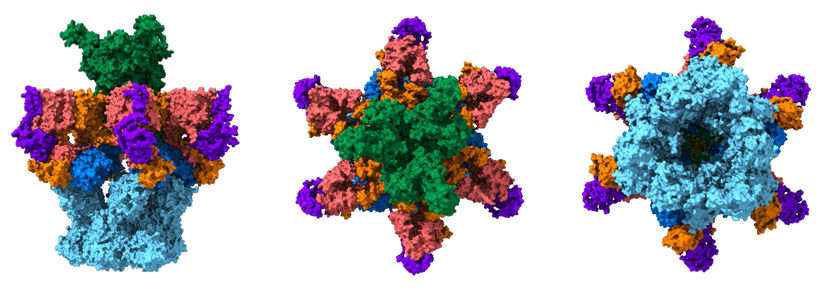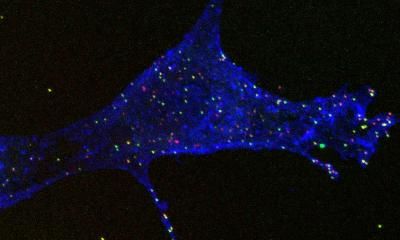Tuberculosis: New insights into the pathogen
Researchers at the University of Würzburg and the Spanish Cancer Research Centre have gained new insights into the pathogen that causes tuberculosis. The work published in Nature provides the basis for a new approach in antibiotic therapy.

Model of the secretion system of Mycobacterium tuberculosis.
Sebastian Geibel
Tuberculosis is a highly contagious infectious disease that is typically spread through aerosols and mainly affects the lungs. According to the World Health Organization (WHO), an estimated 1.7 million people die from such an infection worldwide every year. In addition, a quarter of the world's population carries a form of tuberculosis that lies dormant without symptoms for a long time, but can break out eventually.
Nanomachines in the cell envelope
During infection Mycobacterium tuberculosis, the main causative agent of tuberculosis, secretes a large number of effector proteins through type VII secretion systems – small nanomachines which are composed of proteins that reside in the cell envelope. The effector proteins are specialized in fighting the immune defense or enable the uptake of nutrients to ensure the bacterial survival in the host. How these central secretion systems work, is still poorly understood.
Scientists from the Julius-Maximilians-Universität Würzburg (JMU) and the Spanish Cancer Research Centre CNIO (Centro Nacional de Investigaciones Oncológicas) have now succeeded in deciphering the molecular architecture of these nanomachines. Dr. Sebastian Geibel, who heads a research group at the Institute of Molecular Infection Biology funded by the Bavarian Elite Network and who is also affiliated with the Rudolf Virchow Centre of the JMU, was in charge of this work. The scientists have published their work in the current issue of the journal Nature.
Measurements at very low temperatures
Over the past five years, the research group of Dr. Geibel has worked intensively on the stable reconstitution of one of these secretion machines and the preparation of the sensitive sample for measurements on the cryo electron microscope, which requires the protein complexes to be shock frozen under defined conditions.
In collaboration with the research group of Oscar Llorca in Madrid, which computed three-dimensional maps of the protein complex using a sophisticated data processing strategy, the researchers from Würzburg were able to create a model of its molecular structure. The researchers were able to identify important elements of the nanomachine that form the transport pore as well as to locate elements that convert chemical energy into motion and thus drive the transport of effector proteins through the pore.
New approach for new drugs
The findings of the researchers lead to a deeper functional understanding of Type VII secretion systems. In times of rising resistance of mycobacteria to the antibiotics in use and no effective vaccination against tuberculosis in place, the researcher provide an important basis for the development of novel antibiotics that target the assembly or function of the type VII secretion systems.
Original publication
Most read news
Original publication
"Architecture of the mycobacterial type VII secretion system"; Nikolaos Famelis, Angel Rivera-Calzada, Gianluca Degliesposti, Maria Wingender, Nicole Mietrach, J. Mark Skehel, Rafael Fernandez-Leiro, Bettina Böttcher, Andreas Schlosser, Oscar Llorca & Sebastian Geibel; Nature; 9. October 2019
Organizations
Other news from the department science

Get the analytics and lab tech industry in your inbox
By submitting this form you agree that LUMITOS AG will send you the newsletter(s) selected above by email. Your data will not be passed on to third parties. Your data will be stored and processed in accordance with our data protection regulations. LUMITOS may contact you by email for the purpose of advertising or market and opinion surveys. You can revoke your consent at any time without giving reasons to LUMITOS AG, Ernst-Augustin-Str. 2, 12489 Berlin, Germany or by e-mail at revoke@lumitos.com with effect for the future. In addition, each email contains a link to unsubscribe from the corresponding newsletter.
























































